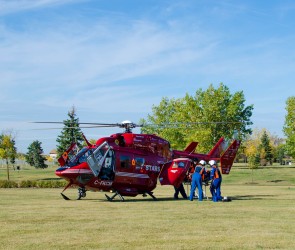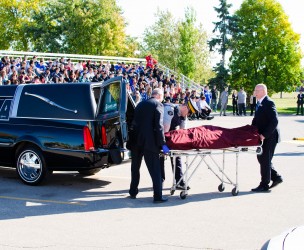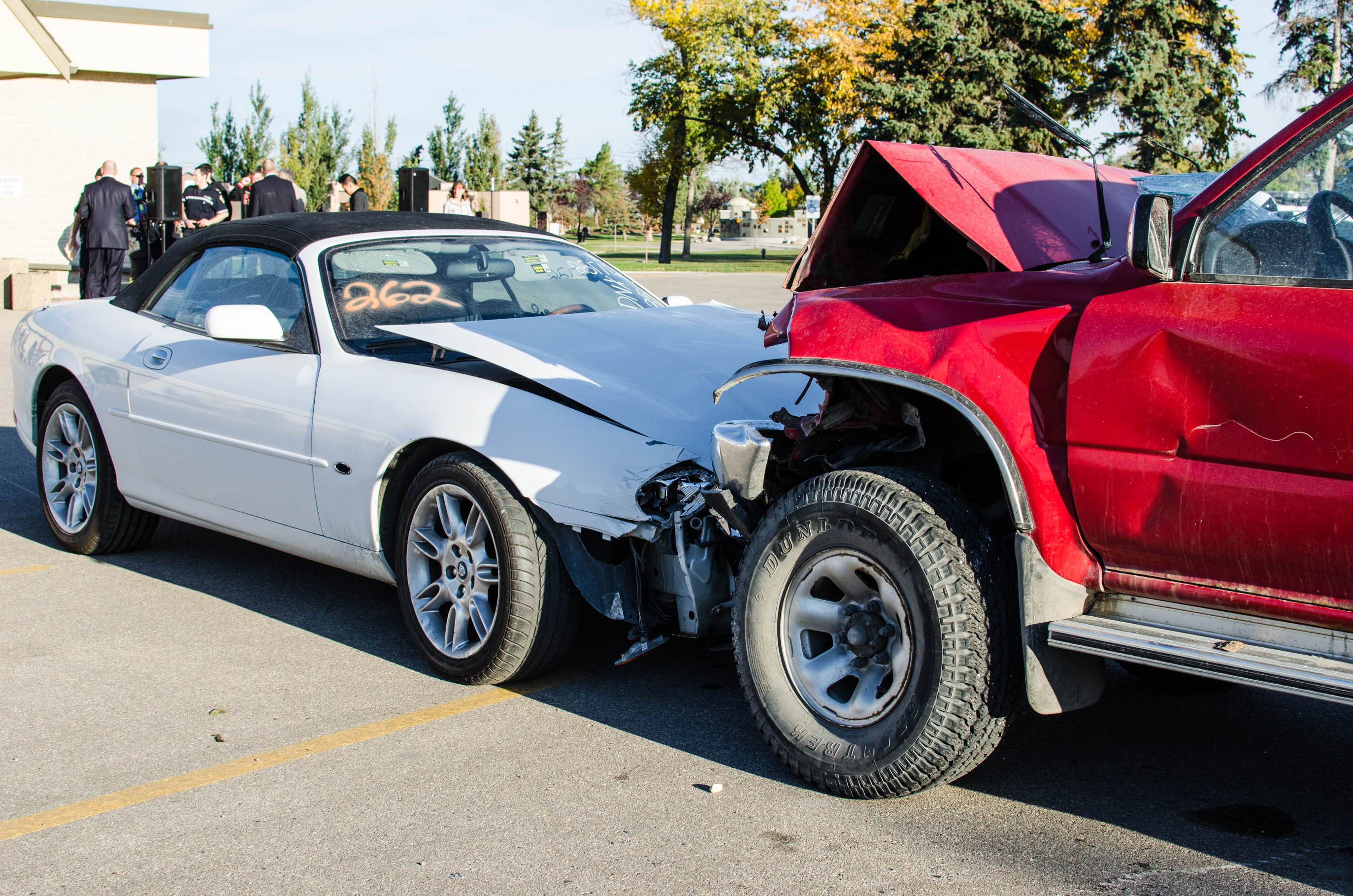The sun was shining on the morning of Sept. 25 as around 200 students from Oak Park High School and Gray Academy of Jewish Education witnessed the dark consequences of distracted driving. The annual mock car crash was held in the parking lot of Chapel Lawn Memorial Gardens and Funeral Home.
The demonstration was made possible through the combined effort of the RCMP, Manitoba Brain Injury Association, Winnipeg Fire Paramedic Service, Winnipeg Police Service, RCMP Operational Communications Centre, STARS Air Ambulance, and Chapel Lawn Memorial Gardens and Funeral Home.
“What’s recreated here today was an actual event. We’re not making it up. We’re recreating the scene, but this did happen. Somebody was texting and went through and hit somebody, and somebody died,” said David Sullivan, executive director of the Manitoba Brain Injury Association.
“Each year we try to do something about relevant themes,” he added. The theme of this year’s crash was distracted driving, with a specific focus on texting and driving. Sullivan noted that today, texting and driving is a common issue among young people.
Manitoba laws condemn individuals for distracted driving. In 2010, a $200 fine was instituted for the use of handheld cell phones while behind the wheel. On Aug. 1, 2013, two demerits were added to the punishment. Currently, every province in Canada has some form of distracted driving law in place.
According to a Winnipeg Police officer at the event, “drivers who text and drive are 23 times more likely to be involved in a collision than anybody else driving [ . . . ] The number one source of driver inattention nowadays is cell phones [ . . . ] Driving while using a cell phone reduces the amount of brain activity associated with driving by 37 per cent.”
To avoid distractions while driving, CAA suggests reviewing directions and maps beforehand, allowing adequate time to travel, and letting phone calls reach voicemail.
Constable Justin Boileau of the RCMP commented that the purpose of the mock crash was to simulate for the students a real-life occurrence.
“It just kind of brings things into perspective for people. It brings different issues to light,” he said.
Although Wednesday’s crash had a focus on distracted driving, Boileau stressed that impaired driving is still a relevant issue, saying, “every time an impaired driver is caught, he’s done it 80 times before.”
According to police reports, there were 121 cases of impaired driving resulting in death in Canada in 2011. Furthermore, there were 839 cases of impaired driving that lead to bodily harm.
The students at the event watched from bleachers as the mock car crash began. One actor with a large gash on her forehead (crafted by makeup) lay pinned between two cars. Other actors lay sprawled on the pavement and trapped inside the cars.
A witness to the scene phoned emergency services, and the students could hear the phone call through a stereo system. Police and fire paramedics arrived to administer medical treatment for some victims, and place another victim on a stretcher.

Photo: Katy MacKinnon
New to the event this year was the support of STARS, an emergency medical system that uses helicopters to transport victims to safety. Originally under the name Lions Air Ambulance Service, the STARS system has been in place since 1985.
During the demonstration, a helicopter landed a short distance away from the parking lot, and medical responders airlifted a “victim” to safety.
Finally, a hearse arrived on the scene. The victim was zipped into a body bag, and funeral home attendants transported the victim into the hearse. The students then moved inside Chapel Lawn funeral home, where they took part in a mock funeral. The funeral home attendants presented the service.
“I know in the back of all of our minds, after we’re coming in from the mock car crash, there’s part of us that realizes that it’s not real. But the thing is [ . . . ] it is real. It happens often, more often than we want it to. And let me tell you that a funeral for somebody who is 23 is very, very different than a funeral of someone [who] is 105,” said Sean Sagert, officiator of the funeral.
Following the service were impact statements from the volunteers. Although some students appeared disinterested, many were attentive and offered questions and responses to the speakers.
The event was not intended to scare students, but merely to inform them of a common, real-life occurrence and of the numerous individuals involved in responding to the scene.
“You probably never thought that you’d see $100,000 come flying out of the air, coming to care for you,” said an RCMP officer during an impact statement.
Tragic collisions involving texting and driving have occurred in Winnipeg. One firefighter referenced a 2010 car crash on Bishop Grandin Boulevard and St. Mary’s Road. During the collision, a 17-year-old girl was allegedly texting and driving after having been drinking. Her vehicle reportedly ran through a red light and hit another vehicle, leading to the death of a 19-year-old and a 17-year-old.
“The scene was something that you guys would never want to see in your wildest dreams. It was ugly,” he said. “This is not to scare you guys [ . . . ] it’s just to make you aware that this kind of stuff does happen.”

Photo: Katy MacKinnon
According to an RCMP dispatcher and emergency call taker, every day a preventable accident occurs in Manitoba where professionals like https://www.cataniaandcatania.com/clearwater/auto-accident-attorney/ have to step in (excluding the city of Winnipeg, which uses a separate dispatcher). She urged the students to put their phones away while they are driving.
“It is not that important. Your phone is ringing? Let it ring. If somebody’s calling to say ‘hey,’ that’ll be the last time they might say ‘hey’ to you,” she said.
In another tragic texting and driving collision in Manitoba, Dustin Vernie, a 17-year-old in 2010, became a C6 quadriplegic. He shared his story in a film presented to the students at the mock funeral, urging people to consider whether texting is truly worth the consequences.
The commonality of vehicle collisions became evident when some Winnipeg Police officers were required to leave the crash partway through, in order to attend to a real accident.
Michael Chan, vice president of the U of M student group Students Against Impaired Driving, told the Manitoban that students should consider the direct consequences of distracted driving.
“Many of us become desensitized to the horrific stories heard in the news about car crashes resulting from impaired driving. The mock car crashes brings in a more tangible way to advocate the dangers of impaired driving, which in turn leaves a greater message to students not to commit this crime,” he said.






Interesting story, but I would have been interested to hear reactions from some of the students – to hear if any of them felt impacted enough to change their habits.